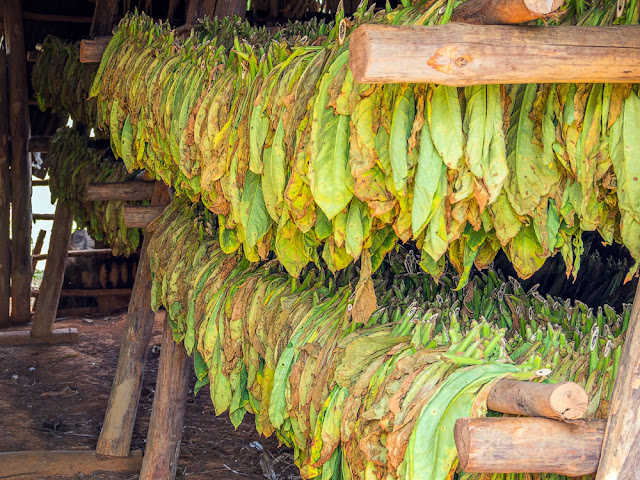The key crop in Vinales is tobacco, a cash crop for the farmers rather than one for food. Still, it was a pleasure to watch the slow, rhythmic harvesting of the leaves. Against the stunning backdrop of the limestone mogotes, on the rich ochre plain the scene was imbued with an epic quality, like watching a film in widescreen. My romantic reaction is hard to reconcile with the devastating effects to health of smoking itself, I know.

Tobacco is planted in November and harvested in March. The leaves are picked by hand: wonderful to watch but hard on the back for the picker!
Vinales is all about traditional agriculture. Oxen plough the fields and pull carts. Horses are everywhere too: horsepower is literal not a unit of measure. This stepping back in time is what makes Vinales so appealing. Everything seems simpler and slower, and sometimes we yearn to slow down in a world that seems so fast.
I assumed the lack of mechanisation was due to poverty and low availability of machinery in Cuba. There may be some truth in that, but it seems also that traditional methods produce the best leaves and the best tobacco. I imagine, for example, that the leaves, handled by human hands, do not get damaged and bruised.

The leaves are dried on racks in the fields before being loaded onto ox carts and taken into the tobacco sheds. These simple buildings, made from natural materials, are dotted all over the landscape. They squat on the red earth like tribal huts.

During our short stay, there was always a wind in Vinales, at times it was strong even in the hot sun (beware getting burnt!) It blows softly through the ventilated sheds, its power diffused by the palm leaves on the roofs and the wooden slatted sides so that the leaves dry gently in the shady interior.
The farmers were very happy to let us look inside the sheds. They smelt of warm green grass; earthy and wholesome, in fact. The arrangement of the tobacco leaves on the racks is neat and skilful. Even as the farmer is picking, you can see he is bundling them together in a very specific way (see first photograph). It is, I'm sure, a technique passed down from one generation to the next.


No comments:
Post a Comment